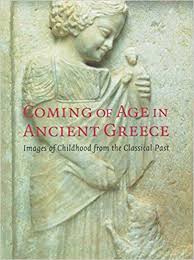Ancient Greek Childhood
Listen to the Recess! Clip
| Author | John Cech |
| Air Date | 4/9/2004 |

Ancient Greek Childhood Transcript
Brief sound clip
That’s Savina Yannatou with the Greek lullaby, “Nanourisma,” from Ellipsis Arts’ beautiful Mediterranean Lullaby CD. With the Olympics approaching this summer, our collective thoughts will once more be looking toward Athens and Greece, the birthplace of democracy, philosophy, as well as those celebrated sporting games that bring the youth of the world together every four years.
We’re all familiar with at least some of the ancient images of young people running and hurling javelins and discs, wrestling and boxing across the black or red surfaces of Greek vases.
But there is another, fuller picture of Greek children and youth that emerges from a remarkable collection of rare art works and other objects currently ending its stay at the Onassis Cultural Center in New York City. The show is called “Coming of Age in Ancient Greece: Images of Childhood from the Classical Past,” and it brings together, for the first time, a view of Greek children and childhood that is both surprising and familiar.
We tend to think that children — unless they were child gods like Hermes or Herakles — were treated indifferently at best and brutally at worst in that place where Western civilization flowered. Children often died in infancy and the gender boundaries that separated girls and boys as they moved into puberty and young adulthood were rigidly fixed, right down to prescribed activities and permissible hair styles. Yet other artifacts in this exhibition offer a fuller picture of children and their lives. Here are clay feeding bottles for infants, and terra cotta tops, delicately jointed clay dolls, and painted horses on wheels. And there are many statuettes and figurines: of children and their mothers and nurses, of children sitting and crawling and giving each other piggyback rides. In bas reliefs and vase paintings, children balance on see-saws and swings, roll hoops, push toy carts, play with their pets, take music and dance and writing lessons, sleep and yawn and stretch out their arms for their mothers. Some things don’t change, no matter how faded or chipped the glazes may become.
Brief sound clip